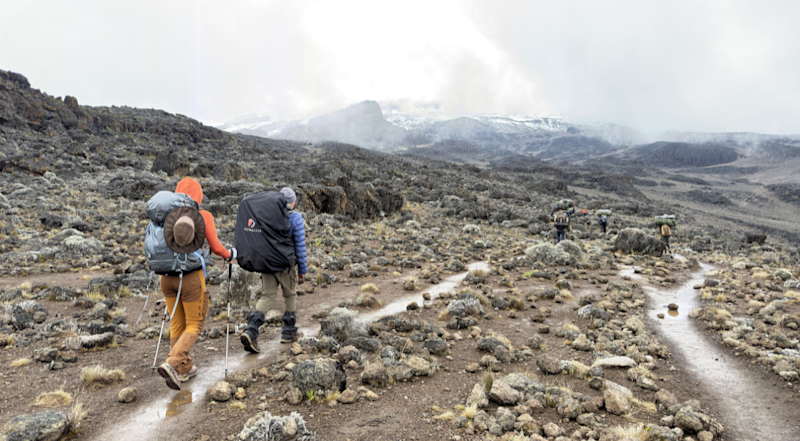What does Kilimanjaro mean?
On the surface, it’s a simple question. But scratch just a little below that snow-capped peak and you’ll find a tangled web of languages, legends, and colonial curiosity.
This isn’t just about what early European explorers called the mountain—it’s about how language and landscape collided in East Africa, how myths shaped geography, and how one name came to embody both greatness and the impossible.
So, let’s climb into it—figuratively speaking (no altitude sickness here). What’s the real meaning of Kilimanjaro, and why does it still stump historians, linguists, and even locals today?
What does Kilimanjaro mean? Origins of the name Kilimanjaro
You’d think Africa’s tallest mountain—rising out of the savanna like a snow-dusted fortress—would have a name with a straightforward backstory. Not quite. Like many iconic places on the continent, the origins of the name Kilimanjaro are anything but simple.
Let’s just say: if you asked the Chagga people, a 19th-century German missionary, and a caravan of Swahili traders what the mountain was called and why, you'd get three different answers—and they’d all be kind of right.
Theory 1: “White Mountain” from Swahili and Chagga
One of the most popular theories is that Kilimanjaro is a sort of linguistic mash-up—a high-altitude remix, if you will.
- “Kilima” means hill or mountain in Swahili.
- “Njaro” is believed to come from the Chagga language, possibly meaning whiteness or shining.
Put the two together, and you get something like White Mountain or Shining Mountain—a poetic name that feels tailor-made for Kilimanjaro’s iconic, snow-capped summit.
And let’s be honest, that snowy crown is weirdly majestic when you’re standing on the equator, squinting at glaciers in the middle of tropical East Africa. No wonder early European explorers were enchanted.
What makes this theory extra compelling is that it actually reflects how the local people see the mountain—both visually and spiritually. The Chagga, who have lived on its slopes for centuries, often describe the peak’s snow as a gift from the gods, or even as a sign of something sacred.
Theory 2: The mountain of caravans
Now for a different vibe—less mystical, more historical.
Some early travellers argued that “njaro” had nothing to do with snow at all. Instead, they believed it referred to the caravans that passed by the mountain on ancient trade routes. In this version, Kilimanjaro becomes the “mountain of caravans”—a kind of massive road sign for Arab traders and Swahili merchants moving goods across the region.
It makes sense when you consider Kilimanjaro’s location. The mountain rises just inland from the Indian Ocean and was a key landmark on pre-colonial trade maps. Spices, ivory, and even enslaved people moved along these dusty routes, and Kilimanjaro stood tall as a guiding post.
It’s a more pragmatic origin story—but no less powerful. This theory connects the name to the lived, travelled, and traded-in world of early East Africa, before GPS and guidebooks.
Theory 3: Mountain of greatness—or the unclimbable giant
Here’s where it gets spicy.
When Johann Ludwig Krapf wrote the name “Kilimanjaro” in his missionary journals in the mid-1800s, he didn’t just transcribe it—he interpreted it. He claimed that the Swahili-speaking people along the coast called the mountain “Kilimanjaro,” which he took to mean Mountain of Greatness.
It’s a powerful title, and it fits. This isn’t just a mountain—it’s the mountain. A volcanic monolith rising 5,895 meters (19,341 ft) above sea level, straddling everything from rainforests to alpine desert, and refusing to blend in with its surroundings.
But there’s also a darker twist to this theory.
Some scholars believe that “njaro” could have meant evil spirits or even difficult or impossible—a warning, perhaps, from the Chagga people or other nearby communities. In this telling, Kilimanjaro isn’t just magnificent—it’s dangerous. A sacred place you don’t mess with. A realm of thin air, sudden snowstorms, and altitude sickness that still takes down even the fittest hikers attempting to climb Mount Kilimanjaro today.
So maybe Kilimanjaro means more than one thing at once: a white mountain, a holy beacon, a warning sign, and a challenge all wrapped up in one daunting silhouette. Ultimately, there will always be things you might not know about Mount Kilimanjaro. The bright side? Research about the magnificent mountain is incredibly interesting.
The Chagga people and their sacred mountain
If you're exploring the meaning of Kilimanjaro, you can't skip the Chagga people. They’ve lived on the mountain’s lush lower slopes for generations, and to them, Kilimanjaro is much more than a snowy backdrop—it’s the heart of their culture.
- Location: Eastern slopes of Kilimanjaro, East Africa
- Agriculture: Bananas, coffee, and maize thrive in the volcanic soil
- Innovation: Developed one of sub-Saharan Africa’s most advanced pre-colonial irrigation systems
- Spiritual connection: The mountain is considered a living, breathing presence
For the Chagga, Kilimanjaro wasn’t just a source of survival. It was a force—benevolent, mysterious, and sometimes dangerous.
Njaro the guardian spirit
One of the most enduring tales about Kilimanjaro is the story of Njaro, a guardian spirit believed to live at the summit. Some versions paint Njaro as a protective deity. Others describe evil spirits that punish those who venture too high—a spiritual no-go zone cloaked in mist and fear. These weren’t just spooky campfire stories. They were survival guides.
Folklore functioned as warning:
- Don't climb too high.
- Don't disrespect the spirits.
- Don’t disrespect the mountain.
- The mountain chooses who may pass.
Today, modern trekkers know the danger comes from something less supernatural but just as unforgiving: altitude sickness. The mountain’s alpine desert zone is bone-dry, low on oxygen, and hits hard if you're not acclimatised.
European explorers and the colonial twist
In the 1800s, early explorers from Europe arrived in East Africa and began documenting Kilimanjaro—through their own lens.
- Hans Meyer, a German geographer, was the first recorded person to reach the summit in 1889—guided by Yohani Kinyala Lauwo, a Chagga man
- Meyer believed the name came from Njaro, possibly referring to a spirit or deity
- Johann Ludwig Krapf, another explorer, described the mountain as a place of wild grandeur and spiritual weight
European writings emphasised:
- The mountain’s beauty
- Its snow-capped peak
- Its “untameable” nature
These accounts helped solidify the image of Kilimanjaro as a mysterious, formidable giant—something both beautiful and impossible. But colonial mapmakers were less poetic. They locked in the name “Kilimanjaro” with little attention to linguistic accuracy or local traditions.
So, while you’ll see it printed across atlases and trekking brochures, the origins of the name Kilimanjaro remain open to debate.
A mountain of many names—and even more stories
Here’s where things get juicy. Kilimanjaro isn’t a one-name wonder—it’s had many names, and each one tells a different story.
- “Mountain of greatness” – interpreted as a symbol of power or divinity
- “Mountain of caravans” – a waypoint for trade and migration routes
- “White mountain” – likely referencing its icy summit
- “Difficult or impossible” – a nod to its treacherous slopes
- Kibo – Chagga for “bright” or “shining”
- Mawenzi – a jagged, less-travelled peak, name meaning unclear but deeply rooted
- Uhuru Peak – named after Tanzanian independence (“Uhuru” means “freedom”)
And then there’s that one legendary translation: Njaro the guardian spirit—said to protect (or punish) depending on your respect for the mountain.
So, if you’re wondering what does Kilimanjaro mean? —the answer is, kind of everything.
Climbing Mount Kilimanjaro today
Every year, hundreds of people fantasize about climbing Mount Kilimanjaro. However, the cultural echoes remain very much alive.
Trail Highlights:
- Rainforest filled with wildlife and waterfalls
- Heath and moorland areas with massive lobelias
- The desolate alpine desert is stark and silent.
- The final stretch: a snow-covered top rim frozen in time
Each ecological zone feels like crossing into a different world. And many climbers say something shifts as they approach the top—it’s not just about altitude anymore. There’s a reverence, as if Njaro the guardian spirit still whispers in the wind.
So, what does Kilimanjaro mean—really?
Let’s cut to it: No one knows exactly. The meaning of Kilimanjaro is a riddle woven from language, legend, and time. There’s no single translation that fits cleanly. But maybe that’s the point.
- It could come from the Chagga word “Njaro,” possibly meaning shining one, whiteness, or spirit
- It might relate to Swahili or other Bantu roots—some suggest “Kilima” means hill, though that’s debated
- Explorers once called the mountain everything from terrifying to divine
- Some believe it was misunderstood by early colonists and misnamed entirely
And yet the name stuck—part myth, part mystery. So, when someone asks, “What does Kilimanjaro mean?”, you can tell them this: It’s more than a name. It’s an invitation to wonder.
Quick Facts Recap
- Kilimanjaro = "kilima" (mountain) + "njaro" (perhaps whiteness, magnificence, or soul).
- The mountain is essential to Chagga religious and agricultural life.
- Believed to be inhabited by guardians or malevolent spirits.
- Known as the "Mountain of Greatness," "Mountain of Caravans," or "Unclimbable Mountain."
- Hans Meyer first noted the summit in 1889.
- The snow-capped summit remains renowned in East Africa.
A name shrouded in stories, not certainty
The true meaning of "Kilimanjaro" remains shrouded in mystery, which adds to its appeal. Languages, local mythology, and colonial influences have all contributed to the name's evolution over time. Some attribute it to ancient stories about spirits, while others cite its gorgeous snow-capped summit as inspiration. In the end, Kilimanjaro's name is as deep and complex as the mountain itself, with cultural nuances and historical twists.
For some, Kilimanjaro draws from the word Njaro—possibly a guardian spirit, or perhaps a glowing presence said to linger at the summit. For others, it’s the “mountain of greatness,” or even the “mountain of caravans,” echoing the long trading journeys that once skirted its slopes. Early explorers like Johann Ludwig Krapf wrote of a place so awe-inspiring it could only be called by something grand. Hans Meyer, the first to summit, didn’t just call Kilimanjaro “snow-capped”—he helped enshrine it in the Western imagination as something mythic, almost untouchable.
What does Kilimanjaro mean? The answers are layered, contradictory, and still evolving. But perhaps the better question is—what does it mean to you?
Because climbing Mount Kilimanjaro isn’t just about altitude. It’s about walking through a story that’s still unfolding. It’s the chance to experience a living monument where folklore and geology collide. And if you’re ready to explore that story for yourself, join a Kilimanjaro climb with Follow Alice and find out what this legendary peak will come to mean in your own journey.
No matter what you call Kilimanjaro, one thing’s clear: its meaning isn’t fixed—it’s found.





